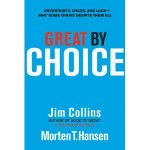Posts Tagged ‘Jim Collins’
How Ideals Power Growth & Profit
Jim Stengel is the former head of marketing for Proctor & Gamble. The ideas he expresses in this book are consistent to those being expressed by Daniel Pink in “A Whole New Mind” and Jim Collins in his latest book, “Great By Choice”.
Stengel preaches that it’s essential for business leaders to combine ideals and artistry, very right-brained functions, with rigorous left-brained analysis in order to create a brand leading product or service . He collaborated with WPP’s Millward Brown Optimor’s neuroscience unit to use MRI’s to measure how quickly people associate ideals with brands.
The Stengel 50 list was created from this research. These companies outperformed the S&P 500 by 400% over the first decade of this century. Most importantly, they discovered that associations with a brand’s perceived ideas have a strong relationship with consumer preference, consideration and choice.
According to Stengel, a Brand Ideal is the essence of the business which is embraced by everyone in the company , from the CEO to the receptionist, and is amplified by everything that the company does. In these cynical times, that’s a tough order. So, like Jim Collins’ concept of “the right person in the right seat on the bus”, Stengel has found that the leaders in his Stengel 50 companies devote a lot of time and attention to recruiting with the idea that one bad hire can be highly toxic.
Daniel Pink talks about the need to think “symphonically”. Apparently, Stengel agrees. He believes that CEO’s need to be “whole-brained” which , I believe, means that they need to take a holistic approach and to think in terms of decades rather than months, quarters, or years. He introduces the concept of the Brand Artist, someone who is accountable for the soul of the brand and its ideal. Stengel says that a company needs to measure its progress on the ideal not only with customers but with employees as well.
According to Stengel , a brand’s success relies on its ability to satisfy one of the following fundamental values: elicit joy, enable connection, inspire exploration, evoke pride, or positively impact society. Bottom-line: your brand has to walk the walk as well as talk the talk in a world that demands transparency and authenticity.
One company on the Stengel 50 list is Chipotle. I’ve never been to one of their restaurants and I thought of Chipotle as another Taco Bell-type franchise. Then, I saw their TV spot during the SuperBowl
and my attitude towards the Chipotle brand changed.
As usual, I “read” the audiobook version. At times, I found the writing to be a bit stilted. Nevertheless, I think you’ll find the stories about the various brands and the concepts in this book to be both useful and enlightening.
Great By Choice
The first time I learned about Jim Collins’ work was several years ago during my first job interview in a decade. I prepared for my interview by reviewing Harvey MacKay’s classic suggestions for responses to interview questions and doing my due diligence about the medical facility to which I was applying. However, when the interviewer’s first question was about how, in my position in the marketing/PR/communications department, I’d improve a patient’s experience, and then talked about getting the right people in the right seats on the bus, I knew that things had changed in the HR world.
“Great By Choice” is Jim Collins’ collaboration with his former student, Morten Hansen, to discover the facts and the myths about why certain organizations far exceed those of seemingly equal competitors. Collins and Hansen compare eight organizations: Southwest Airlines/ Pacific Southwest Airlines, Stryker/United States Surgical Corp., Progressive Insurance/Safeco Insurance, Intel/AMD, Microsoft/Apple, Amgen/Genetech, Biomet/Kirschner, and the 1911 Amundsen and Scott expeditions to reach the South Pole.
Collins and Hansen describe the high performers in their study cases as “10Xers” because these organizations didn’t just succeed but beat its industry index by at least 10 times. They identify three key characteristics of 10X leadership: fanatic discipline, empirical creativity, and productive paranoia. 10X leaders are passionately driven by a cause beyond themselves. As the authors note, all organizations experience both good and bad luck. It’s what one does with the luck they get which matters. They then offer their ideas about the characteristics which describe a “luck event”.
Collins and Hansen confront some entrenched myths to determine their validity. For instance, there’s the concept that a threat-filled world favors the speedy (“You’re either quick or dead”). Instead, the authors suggest that it’s better to figure out when it’s best to go fast and when it’s best to go slow. Also, there’s the firmly held belief that radical change on the outside requires radical internal changes. Collins & Hansen observe that just because an organization’s external environment is experiencing dramatic change it’s not necessarily a good idea for the organization to radically change itself.
“Great By Choice” presents some interesting concepts such as the “20 Mile March”, “Fire Bullets, Then Cannonballs”, “Return On Luck”, “Moore’s Law”, and SMaC. Collins’ and Hansen’s research presents useful answers to the question: Why do some companies thrive in uncertainty, even chaos, while other’s don’t?
No matter whether your endeavor is personal, public service-oriented, or in business, you’ll find the insights provided by this research to be helpful.


